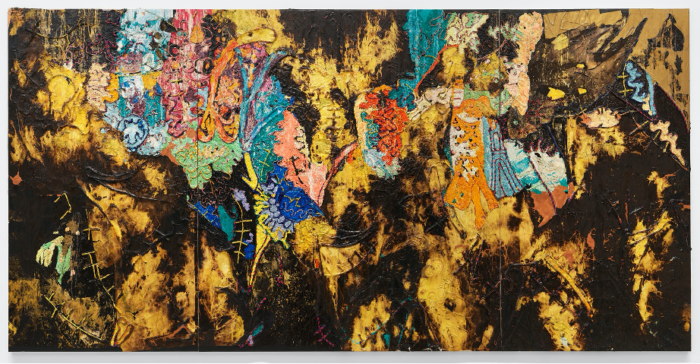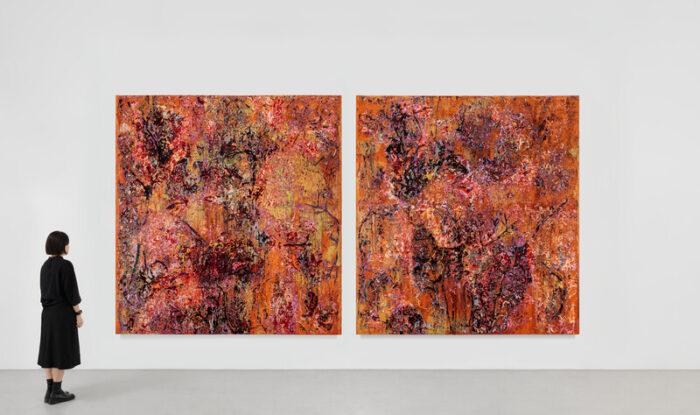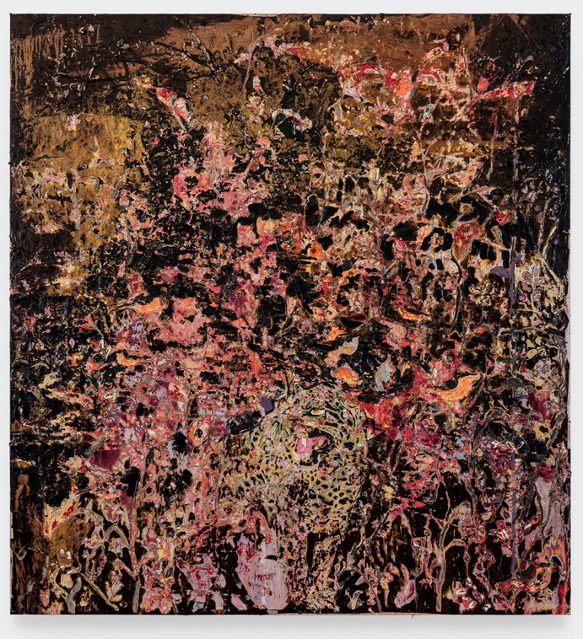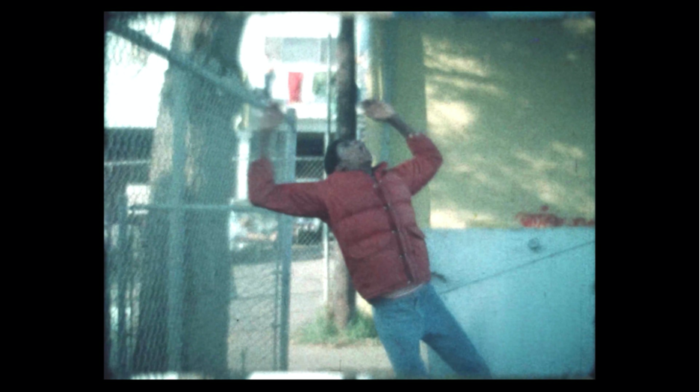Subscribe here to our youtube channel to see more shows.





Mark Bradford. You Don’t Have to Tell Me Twice
13 April – 28 July 2023
Hauser & Wirth New York, 22nd Street
All images: Mark Bradford, © Mark Bradford, courtesy the artist and Hauser & Wirth
New York…Beginning 13 April, Hauser & Wirth will present ‘You Don’t Have to Tell Me Twice,’ a major solo exhibition by Mark Bradford. Filling the entirety of the gallery’s 22nd Street building, the artist’s first show in New York since 2015 sees the artist embarking upon a deeply personal exploration of the multifaceted nature of displacement and the predatory forces that feed on populations driven into motion by crisis. Primarily known for his unique style of ‘social abstraction,’ Bradford has recently turned his attention toward figures, including his own, and has created sweeping new works where flora and fauna––predators and prey––move within dense, dreamlike abstracted landscapes, masses of material, color and line.
The first floor of the exhibition includes a group of recent paintings informed by the history of European tapestry and their socio-political significance, as symbols of the greatest opulence of European aristocracy, and, by extension, their relationship to power. Shown here for the first time since their premiere at the Fundação de Serralves in Porto in late 2021, these works are complemented by new tapestry-like paintings focused upon plant and animal species indigenous to the area around Blackdom, an early 20th century African American homesteader settlement founded in the New Mexico desert, at a remove from the reach of the Jim Crow South. The central figure in these richly layered, monumental tableaux is the Chihuahan desert’s apex predator, the jaguar (Panthera onca), the only living member of the genus Panthera native to the Americas. The symbolic antagonist of Bradford’s exhibition nicknamed ‘Johnny the Jaguar’ by the artist, the roving beast comes to stand in for several kinds of historical predation explored through the exhibition.

The juxtaposition of paintings from the two series of tapestries generates a strong connection between history and the present day, suggesting that the medieval period is a resonant metaphor for modern conflicts and social tensions that have been happening for centuries and remain intractable today. In formal terms, Bradford’s tapestry-like works shift the perspective in his celebrated oeuvre from the aerial bird’s-eye view of the cityscape familiar in his work since the early 2000s, to an interpersonal perspective that puts the audience on an eye-to-eye level with his allegorical world of survival, violence, and desire. This important shift in orientation implicates the viewer in the chase and constitutes a departure in Bradford’s work that puts the figure as the starting point of his abstraction.
The exhibition also presents a group of monumental canvases––including the show’s namesake painting ‘You Don’t Have to Tell Me Twice’ (2023)––that continues Bradford’s ongoing exploration of the Great Migration of African Americans out of the South, perhaps the largest movement of people in the nation’s history. Based on a chart showing travel distances between railroad centers in the United States from the 1920s, these paintings feature gridded numbers and city names created with oxidized paper and caulk, forming a veritable parallel landscape of the continental United States. In these works, the vibrant palette of Bradford’s tapestry paintings give way to more muted tones of stained canvas and paper oxidized to soft grays, tans, and whites in a sober evocation of the urgency in uprooting oneself in the face of catastrophe. The paintings’ titles invoke an imaginary, but just as resonant and historically riven, embodiment of the South, William Faulkner’s fictional Yoknaptawpha County, the Mississippi setting for all but three of Faulkner’s novels, beginning with ‘Sartoris’ in 1929, a place of postbellum brutality, racism, family ties and entangled histories.

Two self-portraits placed at different locations within the exhibition anchor an overarching narrative drawn from the artist’s persistent awareness of his own body and its particular vulnerability. ‘Death Drop, 1973’ (1973)––a scene taken from a Super 8 film directed by Bradford at age 12––portrays himself falling as though struck by a bullet. The slow-motion clip loops in a gallery on the building’s second floor. Three floors above, ‘Death Drop, 2023’ (2023)––a larger-than-life sculpture of the artist’s body positioned in the iconic ‘death drop’ pose popularized in gay ballroom culture––gestures again to the intersection of performance and persecution. Together the works form autobiographical bookends that pull focus from the natural landscape of the paintings to a figure fleeing across them, locating the socio-critical authority and impact of the exhibition within the artist’s lived experience.
In partnership with Culture for One––a non-profit organization committed to improving the lives of New York City children and young adults living in foster care by providing them with arts opportunities and exposure to local cultural communities––Hauser & Wirth and Mark Bradford have devised a learning program to accompany the exhibition that will engage with a group of young people, ages 18 – 24, from the foster care system. Participants will work directly with Bradford to build a framework for a series of public engagement events, helping them to build confidence and acquire new skills as they lead members of the public on guided visits of the exhibition.
Additionally, the gallery has partnered with StoryCorps Studios to create a welcoming environment where local residents can come together and record authentic stories centered around belonging, home, displacement and migration––themes found throughout Bradford’s exhibition––as told through conversations between students, neighbors, friends and family. Further details surrounding these recording sessions will be provided at a later date.

